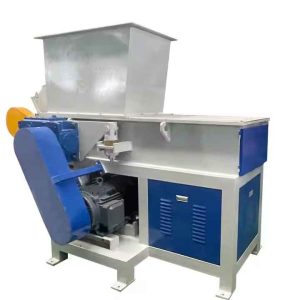1. The selection of shredder
1.clear material type and characteristics
Material type: shredder can handle a wide variety of materials, including plastic, metal, wood, paper, rubber, textiles and so on. Different materials have different hardness, toughness, humidity and other characteristics, these characteristics will directly affect the choice of shredder.
Material size and shape: for large materials, you need to choose a shredder with a larger crushing caliber; for irregularly shaped materials, you need to choose a shredder that can flexibly cope with a variety of shapes.
2.Consider processing requirements
Processing size and particle size: the processing size of the shredder refers to the range of material sizes that can be processed, while the particle size refers to the size of the shredded material. According to the actual demand to determine the appropriate processing size and particle size.
Crushing ratio: Crushing ratio refers to the proportion of size change of the material before and after shredding. The larger the crushing ratio is, the stronger the crushing capacity of the shredder is, but it may also lead to increased energy consumption and wear and tear of the equipment. Therefore, the relationship between the crushing ratio and the performance of the equipment needs to be weighed in the selection process.
Output demand: Output demand refers to the amount of material to be processed per unit of time. This directly affects the selection and configuration of the shredder. Need to understand the equipment processing capacity and stability and other aspects of the performance parameters to ensure that meet the production requirements.
3.Concerned about the performance of the equipment
Crushing capacity: the crushing capacity of the shredder is an important indicator of its performance. According to the hardness and toughness of the material and other characteristics of the choice of the appropriate crushing capacity.
Stability and reliability: the stability and reliability of the equipment is essential to ensure the continuity and stability of the production line. When choosing, you need to pay attention to the operational stability and failure rate of the equipment.
Ease of maintenance: The ease of maintenance of the equipment is also one of the factors to be considered. Easy to maintain equipment can reduce maintenance costs and downtime.
4.Reference to market conditions and brand
Market research: After the use of clear needs, you need to conduct research on the market shredder, to understand the different brands, models of shredder performance, price and other aspects of information.
Brand selection: choose a well-known brands and shredder manufacturers with a good reputation can ensure the quality of equipment and after-sales service.


Click to learn more:https://www.dongdua.com/products/
2.The application of shredder
1.Resource recovery field
Waste plastic recycling: Shredder can shred waste plastic products such as plastic bottles, barrels, frames, etc. into small pieces for subsequent recycling. Through the processing of shredder, waste plastics can be transformed into recycled materials for manufacturing new plastic products, realizing the recycling of resources.
Scrap metal recycling: Shredder can easily process all kinds of metal waste, such as cans, scrap steel and so on. After the shredder’s crushing process, these metal wastes can be turned into smaller pieces for subsequent smelting and reuse.
Waste Wood Recycling: For waste wood, planks, wood, etc., the shredder can crush them into small pieces or granules for subsequent processing. These crushed wood fragments can be used to make wood-plastic composite materials, biomass fuels, etc., realizing the effective use of wood resources.
2.Solid waste treatment field
Municipal waste treatment: the shredder can effectively crush the large pieces of municipal waste, construction waste, etc., to reduce the volume and facilitate the subsequent classification, transportation and processing.
Organic waste processing: shredder can also be crushed organic waste, for subsequent biological fermentation, composting and other processing to provide convenience.
3.Plastic processing field
Plastic raw materials crushing: in the plastic processing process, the need for plastic raw materials for crushing, crushing and other processing, so that the subsequent molding, processing and other processes. Shredder through its efficient crushing capacity, can improve production efficiency.
4.Wood processing field
Crushing of wood raw materials: In the process of wood processing, wood raw materials need to be crushed, cut and other treatments, so that the subsequent process of making boards, lumber and other processes. The shredder can improve the production efficiency through its powerful crushing capacity.
- Other fields
Textile material reuse: Shredder can crush waste textiles such as old clothes, curtains, etc. into fibers for subsequent regeneration process.
Special materials processing: shredder can also be used to deal with some special materials such as cable, tires, etc., through the crushing process to make it easier to separate and recover the useful components.
In summary, the selection and application of shredder need to be based on specific material types, processing needs, equipment performance and application scenarios and other factors for comprehensive consideration. Through scientific and reasonable selection and application, can give full play to the advantages of shredder, improve production efficiency and resource utilization.
Related links:https://baijiahao.baidu.com/s?id=1781877185563384473&wfr=spider&for=pc
Post time: 7 月-04-2024





